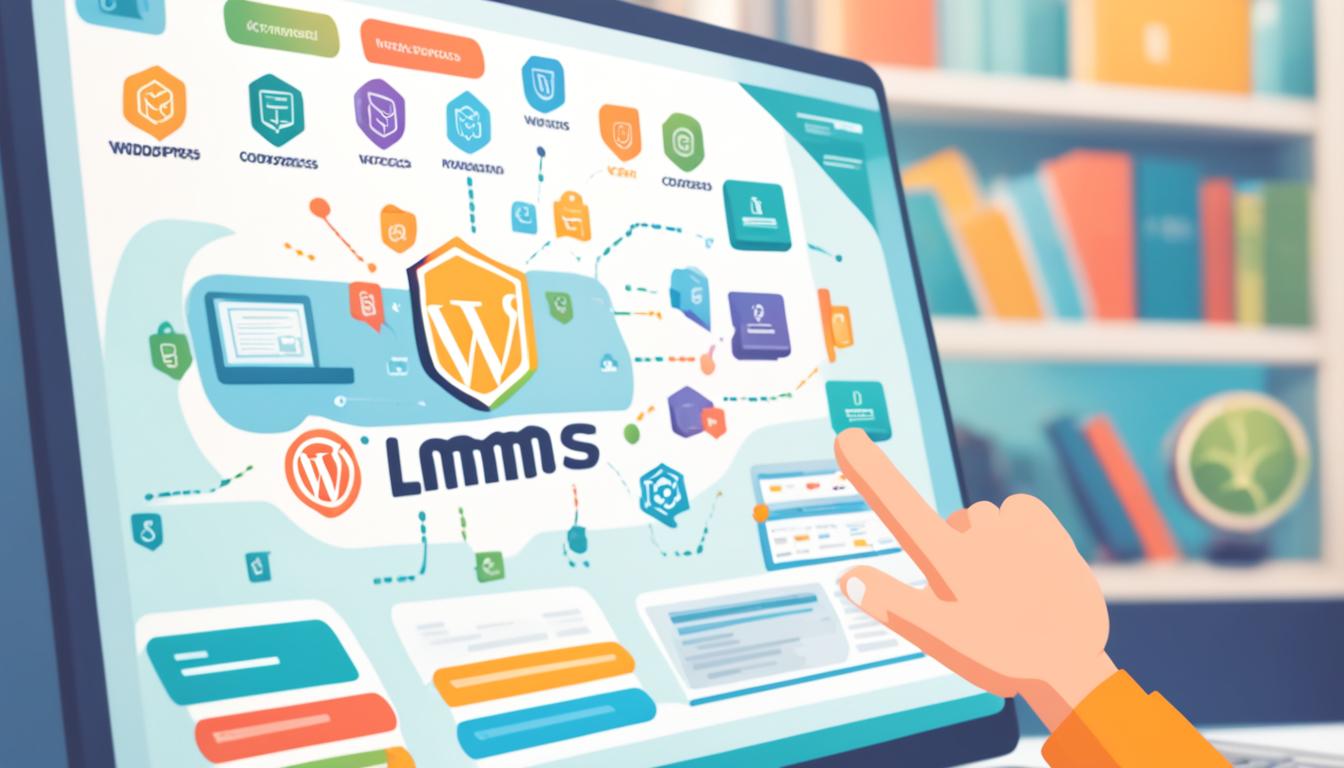Setting up a learning management system (LMS) on WordPress makes online learning easy. It’s a great way to deliver courses online. You can make your WordPress website a simple place for people to learn. It’s all about using the right tools and creating the right look for your site.
Key Takeaways:
- WordPress LMS Setup is a valuable tool for delivering online courses and training materials.
- Integrating a learning management system into your WordPress site offers a user-friendly platform for online learning.
- Designing an educational website is crucial for an engaging user experience.
- Choosing the right LMS plugin is essential for customization and functionality.
- Installing and configuring the LMS plugin is a necessary step for setting up the system.
The Benefits of Using a Learning Management System
Using a learning management system or LMS can bring many benefits. It is like an online learning platform where you can do all your educational work. Here are the good things about using an LMS in your group.
Time and Cost Savings
An LMS saves time and money compared to traditional in-person classes. You don’t need physical classrooms or worry about travel costs. This lets learners study from anywhere, fitting their own schedules.
Customization and Adaptability
You can customise an LMS to match your group’s training goals. This means you can make it look like your brand with the right colours and logos. You can also shape the learning experience to what your learners like, creating a more personal and fun place to learn.
Automated Learning Processes
An LMS can do a lot of the work for you once it’s set up. It enrolls learners, follows their progress, and creates reports on how they’re doing. This saves you time on the boring bits so you can focus on making your content the best it can be.
Efficient Progress Tracking
With an LMS, keeping an eye on how learners are doing is easy. It shows you detailed analytics and lets you compare individual and group work. This can help you see where you need to help your learners do better, making your training the best it can be.
Collaboration and Engagement
An LMS encourages people to talk and work together. Learners can chat, join in discussions, and do activities together. This makes a fun place for sharing ideas and helping each other out.
Using a learning management system can change how you do training and education. The benefits of this online learning platform include saving time and money, being customisable, taking care of most tasks automatically, tracking progress well, and making it easy for everyone to work together.
Now, we’ll look at how to pick the best LMS plugin for your WordPress site next.
Choosing the Right LMS Plugin for WordPress
Setting up an LMS on WordPress needs the right plugin for your needs. Many plugins like MemberPress Courses and LearnDash are out there. Choose one that fits your course creation, protects content, and handles payments.
First, figure out what you are teaching and who you are teaching it to. Think about your course content and access rights. This helps you pick a plugin that works with premium memberships and protects content.
Next, look into various LMS plugins. Read about their features, what users say, and their scores. Aim for one that’s easy to use and has helpful guides. Make sure it plays nice with other WordPress tools and themes.
Also, check how much different plugins cost. Some are one-time payments, others need regular fees. Think about your budget and how big you want your e-learning site to grow.
Your perfect LMS plugin depends on your goals. Research all options well before choosing. Look for features that meet your site’s needs and aims.
Picking the right LMS plugin is crucial. The best one will make learning online easy, fun, and well-organised. So, take time to find the best WordPress LMS plugin for your e-learning site.
Installing and Configuring the LMS Plugin
After choosing your LMS plugin for WordPress, the next task is to install and set it up. Luckily, this process is simple. Most LMS plugins are quick to install via the WordPress dashboard.
- LMS Plugin Installation: Start by logging into your WordPress admin area. Head to “Plugins” and then “Add New.” Search for your selected LMS plugin. Once found, hit “Install Now.” WordPress will install it for you. Click “Activate” to turn it on.
- LMS Plugin Configuration: Once the plugin is activated, set it up as needed. You can tweak various settings to match your requirements. Configuration options may differ based on the plugin, but you’ll generally find:
Membership Levels: Create different membership tiers for course access control. You can have free, paid, or premium levels. For each level, assign what they can see and how much it costs.
Payment Options: Pick a payment gateway, like PayPal or Stripe, for your LMS. You’ll need to link your merchant account. This enables safe online payments.
Course Access Restrictions: Manage who sees specific courses. You can decide which membership level is needed or if there are any prerequisites. You can also make courses expire or control how many can join.
Following the setup tips from your plugin’s developers is key. Each plugin has its own setting up steps. Always check the documentation or seek support for help.
Example: LMS Plugin Settings
| Setting | Description |
|---|---|
| Membership Levels | Define different membership levels and their privileges and restrictions. |
| Payment Options | Configure the payment gateway for secure online transactions. |
| Course Access Restrictions | Set rules for accessing courses, including prerequisites, expiry dates, and enrollment limits. |
With the LMS plugin up and running, you’re almost set to offer fantastic online courses via WordPress.
Creating Courses and Lessons
After setting up your LMS plugin, it’s time to make engaging courses. Good course design helps your students easily move through your content. This makes learning structured and simple.
Organizing Courses into Sections and Lessons
Think about breaking your courses into sections and lessons. Sections group related topics together. For example, a photography course might have sections on camera basics & editing tips.
Each section then contains lessons like “Understanding Aperture.” This approach makes it clear for students to track their progress.
Including Various Types of Content
Use different content types to help all learners and keep them interested:
- Text: For clear explanations and examples.
- Images: To show concepts and examples.
- Videos: For live demonstrations or expert interviews.
- Quizzes: To test what they’ve learned.
Using varied content makes learning fun and interactive. It helps keep your learners’ attention.
Planning Course Content and Learning Objectives
First, plan what you want to teach and your goals. Define what you want your students to learn for each lesson. This helps keep your course focused.
Start by listing the main topics and then break them into lessons. Set clear goals for each lesson. Planning ahead makes your teaching more effective.
Overall, planning your content and aims is key to success. It gives you a clear direction to create great courses that your students will love.
Now, you’re set to learn about designing a user-friendly site. This will make your LMS site a great place for learning.

Designing an Engaging User Interface
Making a fun and useful educational website design is key to success. A good design grabs students’ attention and boosts their learning. Remember a few important things for this.
Choosing a Compatible WordPress Theme
The right WordPress theme greatly affects how your site works for students. Choose one that works smoothly with your LMS plugin. This ensures everything looks and functions well together. A theme should let you change things to match your brand and content too.
Optimizing Layout and Navigation
Your site’s structure and how it’s navigated should be simple. Organise lessons and content logically to help students easily find what they need. Use clear titles and grouping, and add a search bar for extra help. Keeping things straightforward is important to not confuse your users.
Visual Elements for Engagement
Adding eye-catching elements to your site makes students more interested. Use images, videos, and graphics to make information more fun and easy to understand. Pick font styles, colours, and images that fit your brand. This makes your site look polished and interesting.
“Design is not just what it looks like and feels like. Design is how it works.” – Steve Jobs
Usability Testing for a Seamless Experience
Testing your site’s ease of use is very important. Get feedback by letting real users test it. They can tell you how the site feels to use, reads, and overall experience. This insight helps in fixing any issues and making the learning path smoother.
A good educational site design is more than just pretty looks. It’s really about how students use and enjoy the content. Carefully plan the layout, navigation, and how things look to make learning fun and easy.
| Benefits of an Engaging User Interface | User Interface Design Best Practices |
|---|---|
|
|
Restricting Access to Courses
To make sure only the right students or members can view your courses, use access controls. Most learning management system (LMS) plugins have tools for this. They protect your course content, keeping it just for those who should see it.
Create different levels of membership for your courses. This way, you control who sees what. A basic level might have starter courses, while a premium level could include the advanced ones. It lets you personalise your courses for different groups.
You can go even further and change who sees your courses based on their roles. For example, if someone is a “teacher”, they might get access to special courses. This means only people with certain roles can see these courses.
Membership Levels and Access Restrictions
Setting up different membership levels helps decide who can do what in your courses. You get to decide what each level can see and do.
“Membership levels let you give special content to certain people and manage who sees your courses.”
Maybe there’s a free level with only a few courses available. But then there’s a paid level that unlocks everything. This encourages users to upgrade for better access.
Plus, you can use different price points to attract more learners. Offering various membership levels at different prices can help you reach more people.
Implementing Course Access Restrictions
To limit who can see your courses, work with your LMS plugin’s settings. You’ll find options to restrict access by membership or user role.
“Setting up course access is simple in most LMS plugins.”
Once you’ve set these restrictions, only the right people can view your course materials. This keeps your courses special and adds value to your educational content.
Here’s an example of how it works:
| Membership Level | Access |
|---|---|
| Free | Limited access to introductory courses |
| Premium | Full access to all courses |
| Teacher | Access to course creation and management tools |

This table shows how different membership levels lead to various course access. Users under a free membership can only see certain courses. But with premium, they get to see them all. Teachers also get special tools for creating and managing courses.
By using access controls and membership levels, you keep your content safe and limited to those who should see it.
Tracking and Monitoring Course Progress
An LMS lets you check how well your students or staff are doing. It shows the progress of courses and student performance. This helps know what’s working well and where you can do better.
With an LMS, you can keep an eye on each student’s progress. You’ll see if they’ve finished the course, parts of it, and how they did on quizzes. This means you can look at each student’s work or check the whole class’s results in reports.
It highlights students who might need some extra help. You’ll notice where they find things hard. Then, you can adjust how you teach to help them better.
Knowing how students are doing highlights what’s working in your course. You can see how much time they spend on the course, how they do in quizzes, and how engaged they are. This data helps you make your course materials and teaching methods better.
You can use the information to see how good your teaching is. By looking at teaching methods and student results, you can make changes that help everyone learn more.
To see this tracking and analysis in action, have a look at the table below:
| Metrics | Description |
|---|---|
| Course Completion | Track the percentage of students who have completed the entire course. |
| Module Completion | Monitor the completion status of each module within the course. |
| Quiz Scores | View individual quiz scores to assess student understanding and performance. |
| Time Spent | Analyze the amount of time students spend on each module or activity. |
| Engagement Level | Measure student engagement by tracking interactions with the course materials. |
The LMS’s features help you make your courses better. They show how to teach in ways that improve learning. With these insights, you can offer more personal support. This makes learning more interesting and productive for everyone.
Providing Support and Resources
As an LMS administrator, providing strong support and many learning resources is key. This helps students on their learning path. They get the guidance and materials needed to do well.
1. Dedicated Support System
Having a support system, like a forum or chat, is great for connecting students and teachers. It lets students ask questions or get help fast. This also makes a space where students can work together and share knowledge.
2. Resource Library
Setting up a resource library is also important. It has many things like guides, video lessons, and other resources. Providing a lot of options meets different student needs.
Make sure to keep these resources up to date. Adding new items keeps students interested. It also pushes them to learn more about the topic.
| Support and Resources | Highlights |
|---|---|
| LMS Support | A dedicated support system allows students to seek assistance and resolve queries effectively. |
| Learning Resources | A resource library with documentation, video tutorials, and other materials provides comprehensive educational support. |
By offering top-notch support and resources, you make a positive learning space. This keeps students motivated and makes reaching their study goals more likely.
Promoting Your LMS and Encouraging Engagement
Now, as your learning management system (LMS) runs smoothly, let’s focus on getting more eyes on it. Promoting your LMS well is key to drawing students and showing your course’s worth. Use various marketing methods such as social media, emails, and teaming up with industry peers. This way, you spread the word about your LMS to potential students.
Yet, getting your LMS out there is just the beginning. Keeping students involved is a big part of making the learning experience great. Add fun elements like games, quizzes, and forums to make learning engaging. With these interactive tools, students will enjoy participating and be more likely to finish their courses.
It’s also crucial to always check and improve how you advertise and engage students. Keep track of what works and what doesn’t in your marketing and engaging efforts. Then, make changes where needed to ensure students have a top-notch experience. This way, your LMS will not only keep your current students interested but also attract new ones.




